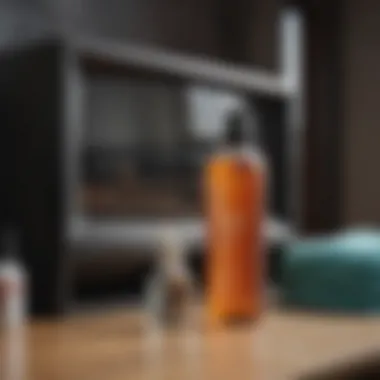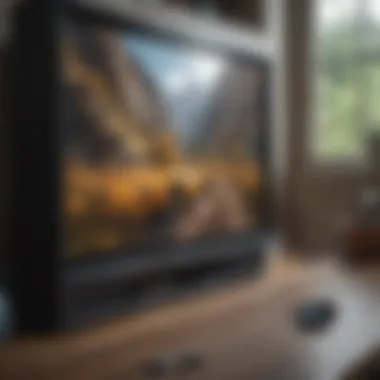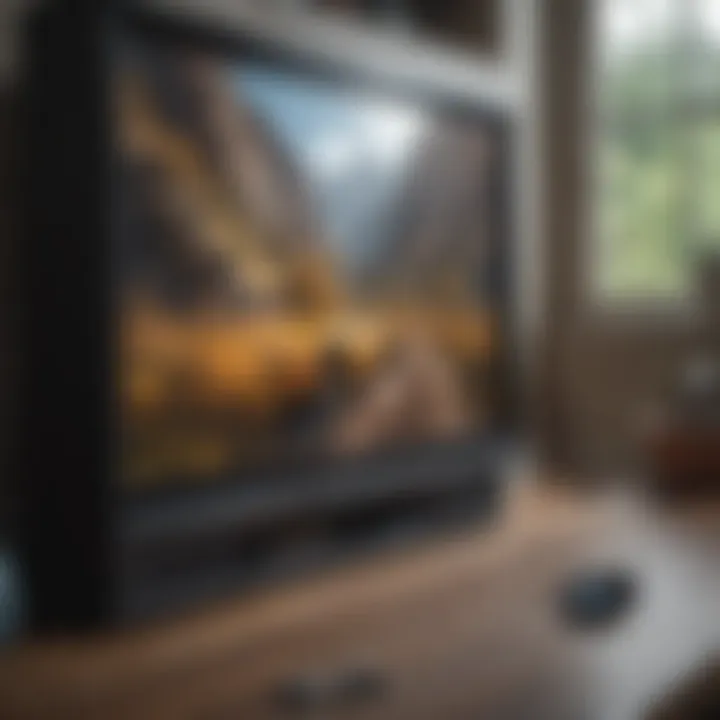DIY Guide to Cleaning Your TV Screen Effectively


Intro
Taking care of your television is essential for maintaining its performance and longevity. A clean screen not only enhances your viewing experience but also contributes to the overall appearance of your living space. However, commercial cleaners can often contain harsh chemicals that may damage vulnerable LCD and OLED screens. Thus, this guide aims to provide you with valuable insights into creating a homemade cleaner that is not only effective but also safe for your device.
In the sections that follow, we will explore the types of screens you may encounter, the materials necessary to formulate a cleaner, and step-by-step instructions for its preparation and application. We will also highlight common mistakes to avoid during the cleaning process and discuss maintenance tips to preserve your screen's integrity. This knowledge is tailored for homeowners, design enthusiasts, and technology users alike, ensuring you can care for your devices responsibly and effectively.
Understanding the Importance of Screen Maintenance
Maintaining the cleanliness of your TV screen is more than just an aesthetic concern. It has implications for both the lifespan of the device and the quality of your viewing experience. Dust, fingerprints, and other smudges can distort colors and reduce the overall brightness of your screen. This obfuscation not only detracts from your enjoyment but may also lead to long-term damage if left unchecked.
Regular maintenance can enhance the longevity of your television. Eliminating dirt and grime prevents the build-up of materials that can seep into and tarnish components. Therefore, adopting a routine for junk removal can ensure that your investment in high-quality technology pays off over time. Furthermore, the practice of keeping the surface clean contributes to healthier viewing conditions in your living space by cutting down on allergens and irritants.
The Impact of Dirt and Smudges on Display Quality
Dirt and smudges on a screen can have a significant effect on the quality of the image. When a screen is not clean, the colors may appear washed out, and details may be obscured. This issue is particularly pronounced on high-definition displays, where clarity is paramount.
Studies have shown that even minor residue can cause a reduction in contrast, which ultimately diminishes the visual experience. Smudges can also create distracting reflections, making it challenging to see the content clearly. For those who prioritize a superior viewing experience, this is a critical aspect that merits attention. Regular cleaning not only maintains the aesthetic appeal but directly affects performance.
Why Use a Dedicated Cleaner
It might be tempting to grab a household cleaner or a paper towel to handle smudges, but this could lead to unintended consequences. Commercial cleaning agents often contain harsh chemicals that can strip the protective coatings applied to modern screens. Furthermore, using inappropriate materials can lead to scratches or damage that is irreversible.
A dedicated homemade cleaner is safer and more effective. The components used can be gentle enough to clean without harming the screen, while still being strong enough to remove common residues.
Consider the effectiveness of simple solutions like distilled water mixed with white vinegar. Such agents are known for their cleaning properties without introducing risk to your device's surface. This approach allows for peace of mind, knowing that the cleaner is tailored specifically for your screen type, thereby ensuring both safety and efficacy.
Types of TV Screens
Understanding the various types of TV screens is crucial for effective cleaning and maintenance. Each screen type employs different technologies that may require distinct care methods.
and LED Displays
LCD, or Liquid Crystal Display, alongside LED, which stands for Light Emitting Diode, are prevalent types used in most modern televisions. LCD screens function by manipulating light and colors through liquid crystals, providing vibrant images and good resolution. They are generally more affordable compared to other technologies.
The cleaning of LCD and LED screens is relatively straightforward. A gentle approach is necessary, as these screens can scratch easily. A designated cleaner specially formulated for these surfaces often yields the best results. Using the homemade solution can safely remove dirt and smudges without damaging the screen's delicate surface.
OLED Technology
OLED, which stands for Organic Light Emitting Diode, represents the forefront of display technology. This type of screen offers superior contrast and color accuracy, making it highly sought after by enthusiasts. Since each pixel emits its own light, OLED screens tend to produce deeper blacks and vibrant colors.
Due to their advanced technology, OLED screens require meticulous care. It's essential to avoid harsh chemicals, as they can degrade the organic compounds in the display. Using a homemade cleaner is beneficial as it tends to be free of harmful additives. With proper handling, OLED screens maintain their superior performance and aesthetic allure.
Plasma Screens
Though less common today, plasma screens still exist. They utilize small cells filled with gas that emit light when electrically charged. Plasma displays are known for delivering excellent color and viewing angles.
Cleaning plasma screens should be approached with caution. The glass surface is somewhat robust, but abrasive materials can cause scratches. A gentle homemade cleaner can be effective, provided it is not overly applied. Ensuring the screen is off during cleaning helps avoid any screen burn issues.
Overall, recognizing the unique features of different TV screen types assists homeowners in choosing appropriate cleaning methods.
"Understanding your TV screen technology is just as significant as the cleaning solution you employ. The right technique ensures longevity."
By customizing care to each screen type, users can maximize their viewing experience and prolong the lifespan of their devices.


Ingredients for a Homemade Cleaner
Understanding the ingredients used for creating a homemade cleaner is crucial for maintaining the clarity and longevity of your TV screen. The right components help ensure that your cleaning solution is effective yet safe, limiting the risk of damage to your device. Using common household items, you can formulate a cleaner that is both efficient and easily accessible. This section delves into the essential components and optional additives that make up a reliable homemade television cleaner.
Essential Components
Distilled Water
Distilled water serves as the base for many cleaning solutions due to its purity. The main characteristic of distilled water is that it goes through a process of distillation, removing impurities and minerals often found in regular tap water. This is beneficial because these minerals can leave streaks or remain on your screen after cleaning. Moreover, distilled water does not introduce any unwanted substances that could react negatively with other cleaning ingredients. The use of distilled water minimizes spots, making it an excellent choice for creating a quality cleaner. However, it's worth noting that distilled water alone may not be as effective at dissolving grease or grime compared to ingredient mixtures that include vinegar or alcohol.
White Vinegar
White vinegar is a powerhouse when it comes to cleaning. Its acetic acid content makes it an adept agent for cutting through grease and stubborn stains on screens. This ingredient is popular in homemade cleaners because it not only eliminates dirt but also serves as a natural disinfectant, effectively killing germs and bacteria. The unique feature of white vinegar is its ability to evaporate quickly, leaving surfaces streak-free. While its strong scent might not appeal to everyone, it dissipates fast, leaving behind a clean screen. However, one must consider that vinegar is not recommended for all types of screens, particularly those with special coatings, so ensure compatibility.
Isopropyl Alcohol
Isopropyl alcohol, often referred to as rubbing alcohol, is known for its versatility in cleaning applications. It acts as an effective disinfectant and is particularly beneficial for cutting through oils and residues left on the screen. This component is favored for its fast-drying nature; it evaporates quickly, reducing the risk of moisture damage to electronic components. Furthermore, isopropyl alcohol is relatively inexpensive and accessible, making it a practical addition to your cleaner. Nevertheless, cautious use is necessary since high concentrations can risk the surface coating on some screens, so it is advisable to dilute it properly before application.
Optional Additives
While the essential components create a solid foundation for your homemade cleaner, optional additives can enhance the cleaning experience or provide additional benefits.
Olive Oil
Olive oil can be an interesting option when it comes to screen care. It is known primarily for its moisturizing properties, which may help in revitalizing certain surfaces. However, its primary use is not traditional for screen cleaning. While it can offer some benefits in terms of shine for certain materials, it can leave residues that attract dust. Using olive oil requires careful consideration as its effectiveness for screens is debated. It is better suited for wood or leather care rather than electronic screens, so caution is advised if you are considering adding it.
Essential Oils
Essential oils are often lauded for their pleasant fragrances and potential cleaning properties. They can add a refreshing scent to your cleaner, making the cleaning process more enjoyable. Some essential oils, like tea tree and lavender, possess antimicrobial properties. However, incorporation requires attention to dilution levels, as concentrated oils can damage screens or leave oily residues. It's best to use them sparingly and only in moderation to avoid overwhelming the solution with scent or causing unwanted effects on the screen surface.
In summary, the ingredients in your homemade cleaner play a pivotal role in the effectiveness and safety of the cleaning process. Thus, understanding each ingredient’s function and suitability is essential for successful results.
Step-by-Step Preparation of the Cleaner
Preparing a homemade cleaner for your TV screen is crucial to ensure its effectiveness and safety. This section highlights the importance of methodical preparation, which contributes to achieving optimal results. A careful approach not only maximizes the performance of your cleaner but also minimizes risk to your screen's delicate surface. Proper preparation aligns closely with the considerations for the types of screens discussed earlier.
Gathering Necessary Materials
Before you start creating your cleaner, it’s important to gather all necessary materials. Having everything on hand saves time and helps prevent mistakes later in the process. Here's a list of materials needed:
- Distilled Water: This is essential because it lacks minerals found in tap water that can leave residue on screens.
- White Vinegar: It is an effective natural cleaner with antibacterial properties.
- Isopropyl Alcohol: This component helps in cutting grease and disinfecting surfaces.
- Spray Bottle: To mix and apply the cleaner easily.
- Soft Cloth: Microfiber cloths are preferred as they are gentle on screens and absorb liquids well.
Collecting these materials in advance allows you to proceed without interruption.
Mixing Instructions
Once you have gathered your materials, you can mix them to form a cleaner. The following ratio is recommended for optimal effectiveness:
- Combine 1 part white vinegar with 1 part distilled water in a spray bottle.
- Add 1 part isopropyl alcohol to the mixture. This helps to break down any tough spots or grease present on the screen.
- Gently shake the bottle to ensure all ingredients are mixed well. It's important not to shake too vigorously to avoid bubbles, which can be counterproductive when applying the cleaner.
Be cautious during mixing; an incorrect balance may lead to a suboptimal cleaning solution that could harm your screen.
Storage Tips
Proper storage of your homemade cleaner prolongs its usability and effectiveness. Here are some tips:


- Store the cleaner in a cool, dark place. Sunlight can degrade the solution over time.
- Clearly label the spray bottle to avoid any confusion with other household chemicals.
- If using any optional additives, ensure they are well mixed and do not interfere with the main formula.
- Check the mixture monthly for changes in smell or consistency; if it seems off, it’s wise to discard it and create a fresh batch.
Taking these precautions will help maintain the integrity of your cleaner, ensuring it's ready for use whenever needed.
Application Techniques for Optimal Results
Application techniques are essential for achieving the best cleaning results for your TV screen. Poor application can lead to streaking, residue buildup, or even damage to the screen. By understanding effective techniques, you can ensure not only a spotless display but also prolong the lifespan of your screen.
Choosing the Right Cloth
Selecting an appropriate cloth for cleaning is critical. Microfiber cloths are often recommended because they are soft and non-abrasive. This reduces the risk of scratching the screen surface. Some individuals might opt for cotton or linen, but these materials can be less effective and may leave lint or residues behind.
Using the right cloth optimizes the interaction between the cleaner and your screen, ensuring an even distribution without harm. Avoid using paper towels or rough fabrics, as these can scratch the screen or cause more build-up of dirt and oils.
Cleaning Process
Dry Wiping
Dry wiping involves using a clean, dry microfiber cloth to remove dust and light smudges from the screen. This method is beneficial for several reasons. First, it does not introduce moisture, which is essential for maintaining the integrity of electrical components. Second, dry wiping is quick and straightforward, allowing for regular touch-ups without the complexity of additional cleaning solutions. The key characteristic of dry wiping is its ability to lift dust and particles without the need for chemicals, making it a risk-free choice.
However, dry wiping is less effective for removing stubborn fingerprints or oily smudges. Therefore, it should be considered as a complementary technique rather than a standalone solution.
Damp Wiping
Damp wiping, on the other hand, utilizes a slightly moistened cloth for cleaning. The moisture helps in loosening tough residues like grease and grime. This method offers an effective strategy to achieve a thorough clean. The key characteristic here is that the cloth is not saturated; instead, it is damp enough to attract dirt without dripping.
One significant advantage of damp wiping is its efficiency in dealing with more challenging stains, ensuring a cleaner display. However, you must be cautious, as excessive moisture can seep into the edges of the screen, leading to potential damage. This method is best reserved for periodic in-depth cleaning rather than daily maintenance.
Frequency of Cleaning
The frequency of cleaning your TV screen depends on various factors such as usage and environmental elements. Ideally, light cleaning can be done weekly using dry wiping to keep dust at bay. For deeper cleans, a damp wipe can be conducted monthly or every couple of months, depending on the screen’s exposure to dust and fingerprints.
Maintaining a schedule helps in preserving the picture quality and functionality of your TV. A consistent routine prevents the buildup of grime and can be a useful practice in preserving the overall aesthetics of your screen, ensuring it looks its best at all times.
Common Mistakes in Screen Cleaning
Cleaning a TV screen involves more than simply wiping it down with any cloth. Understanding common mistakes made during this process can significantly affect your television's longevity and performance. By avoiding these pitfalls, you can maintain clarity and protect sensitive components. Here, we will delve into three major mistakes that often occur when cleaning TV screens and how to avoid them effectively.
Using Abrasive Materials
One of the most significant errors is the use of abrasive materials like paper towels or rough cloths. These can scratch the surface of your screen, especially on delicate LCD or OLED displays. A scratched screen not only diminishes picture quality but can also lead to permanent damage, necessitating costly repairs.
Instead, it is crucial to opt for a microfiber cloth, which is soft and designed specifically for delicate surfaces. Microfiber effectively captures dust and smudges without causing harm. When cleaning, make gentle circular motions to avoid putting too much pressure on any one spot. Avoid any cleaning product that lists alcohol or ammonia on the label, as these can further damage the screen.
Applying Excess Liquid
Another frequent mistake is applying too much cleaning fluid. When excess liquid pools on the screen, it can seep into edges and cause internal damage. Not only does it make the cleaning process inefficient, but it also risks staining or ruining the screen’s display.
To mitigate this, it’s best to apply cleaning solution sparingly. Lightly mist the solution onto the microfiber cloth instead of directly onto the screen. This will provide the necessary moisture to lift grime while preventing liquid from entering the device. Remember, less is more when it comes to liquid application.
Cleaning with Power On
Cleaning a powered-on TV may seem like a time-saving move; however, it is, indeed, a mistake. Doing so can lead to several issues, including accidental input of commands or even damaging the circuitry underneath the screen. More critically, the brightness of a screen can hide smudges or stains that might still be there, leading to an incomplete clean.


Instead, always ensure your television is turned off before beginning the cleaning process. Not only does this ensure safety, but it also provides a clearer view of your screen’s condition. Allow the screen to cool down slightly if it has been in use, allowing for an optimal surface to clean.
Important Note: Always take precautions when cleaning electronics to protect both the device and yourself from potential hazards.
By being conscious of these common mistakes—abusive cleaning materials, excess liquid application, and cleaning with the power on—you can ensure a more thorough and safe cleaning process for your TV screen.
Maintaining Your TV Screen Long-term
Maintaining your TV screen long-term is essential for both aesthetic and functional reasons. Regular upkeep can significantly enhance the viewing experience, prolong the lifespan of the screen, and improve overall performance. Deductions in picture quality can arise from dust accumulation, smudges, or residue left from cleaning solutions. Therefore, a proactive approach to maintenance is ideal. This article will explore essential aspects of establishing a cleaning routine and controlling environmental factors that could affect the quality of your screen.
Establishing a Routine
Establishing a routine for cleaning your TV screen is critical. A consistent schedule can prevent dirt and grime from building up, which can help to minimize the effort required when cleaning. It is advisable to clean your screen at least once a month, but bi-weekly cleaning is recommended in households with high dust or pet hair levels. Determine a time that fits well with your lifestyle, perhaps during a general cleaning session of your living space.
- Select a Cleaning Day: Choose a day to organize your bi-weekly or monthly cleaning routine. This will make it easier to remember and less likely to be overlooked.
- Gather Supplies: Keep your homemade cleaner and cleaning cloth in a designated space for easy access. This encourages you to follow through with your cleaning schedule.
- Review Results: After cleaning, take note of differences in screen clarity. This will reinforce the benefits of your cleaning routine and motivate you to maintain it.
Environmental Control
Environmental factors can significantly affect the cleanliness and longevity of your TV screen. Managing these aspects can create a more optimal viewing area and reduce the need for frequent cleaning.
Sunlight Exposure
Sunlight exposure is an important consideration because direct sunlight can create glare on your screen, impairing viewing quality. Additionally, long exposure to UV light can degrade screen components over time, leading to discoloration or other damage. Protecting your screen from harsh sunlight can not only ensure better visibility but also extend the lifespan of your device.
- Use Curtains or Blinds: Installing curtains or blinds can help control the amount of sunlight that reaches your screen.
- Reposition the TV: If possible, position your TV away from direct sunlight to minimize the impact of light exposure.
- Use Anti-Glare Filters: These filters can mitigate glare caused by sunlight while offering some protection against UV rays.
Humidity Levels
Humidity levels in your environment also play a crucial role in the maintenance of your TV screen. High humidity can lead to moisture buildup, which can affect screen electronics. Conversely, extremely low humidity can contribute to static electricity, which could attract dust and debris. Maintaining a balanced humidity level helps protect your screen from potential damage.
- Optimal Humidity Range: Keeping humidity levels between 30% and 50% is recommended for most electronics.
- Use a Dehumidifier or Humidifier: Depending on your current environment, consider using a device to adjust humidity levels.
- Monitor Indoor Conditions: A hygrometer can help monitor humidity levels so that you can make adjustments as needed.
Maintaining regular cleaning and environmental control will lead to better longevity and performance for your TV screen while enhancing your enjoyment of that much-anticipated movie night.
Safety Considerations When Cleaning Electronics
Cleaning electronics like TV screens involves certain precautions to avoid damage and ensure user safety. Understanding these safety considerations is essential for anyone wishing to clean their devices effectively. Neglecting basic safety measures can lead to various unfortunate outcomes, including equipment damage or personal injury. Therefore, the focus here is on two critical aspects of cleaning electronics safely: turning off all devices and storing cleaning solutions securely.
Turn Off All Devices
Before commencing any cleaning procedure, it is vital to turn off all devices involved. This is not just about avoiding accidental changes or damage; it significantly minimizes the risk of electric shocks. When a device is powered on, the screen may emit static electricity, which can draw dust and dirt more effectively. Also, some cleaners react poorly with electronic components. By turning the device off, you ensure a safe cleaning environment. Additionally, it allows you to inspect the screen for any abnormalities while it is not operational. This is beneficial for spotting any existing damages that may need attention later.
Safe Storage of Cleaning Solutions
Another important consideration involves how and where you store your cleaning solutions. It is crucial to keep cleaning agents out of reach of children and pets. Safe storage also means avoiding areas exposed to extreme temperatures or direct sunlight, which could degrade the effectiveness of the cleaning solutions. Furthermore, properly labeling any homemade cleaner can prevent accidental misuse. Use clearly marked containers and avoid mixing different solutions, as this can create hazardous reactions.
"Proper safety measures during electronics maintenance are as important as the cleaning itself. Ignorance can lead to serious risks."
By following these crucial safety considerations, you can confidently clean your TV screen while ensuring both your equipment and your own well-being remain protected. The effort spent on staying safe will ultimately ensure a better cleaning outcome.
Closure
Maintaining a clean TV screen is crucial, not just for aesthetic reasons but also for the longevity and performance of the device. A dirty screen can distort colors, reduce brightness, and diminish the overall viewing experience. By creating a homemade cleaner, you empower yourself with a solution that is both effective and safe for various screen types. This article has highlighted the fundamental aspects of selecting the right materials, formulating your cleaning solution, and applying it effectively.
The Value of a Clean Screen
A clean screen enhances your viewing experience significantly. Dust, fingerprints, and smudges can obstruct your line of sight, making even the best shows or films less enjoyable. Regularly cleaning your screen helps maintain optimal picture quality, ensuring that colors remain vibrant and details sharp. Over time, neglecting screen maintenance can lead to permanent damage and costly repairs.
Furthermore, using a homemade cleaner allows you to avoid harmful chemicals often found in commercial products. These compounds can degrade screen coatings over time. Instead, by opting for a solution made from distilled water and white vinegar or isopropyl alcohol, you create a safe alternative that will not adversely affect your screen’s surface.
In summary, a clean screen not only improves viewing pleasure but also protects your investment in technology. It is about enjoying content without distractions while prolonging the life of your valuable devices.







